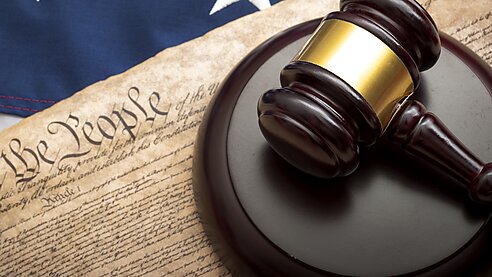This lesson builds on the idea of adequate representation in arrests stemming from civil disorder in racially and politically charged contexts. Students will apply their understanding of the Sixth Amendment to analyze and evaluate court cases during the civil rights movement that would be critical in setting precedence of the amendment’s application in court.
Overview

Figure 3: Four of the Scottsboro Youths and Their Defender Samuel Liebowitz Travel to and Arrive in New York, 1937.
A. “When Do We Leave?,” Associated Press, Nashville, Tennessee, July 26, 1937. Photograph, Sun Newspaper Photograph Collection, Library of Congress, https://www.loc.gov/item/2019630519/.
B. “Scottsboro Youths Cheered on Arrival Here,” Acme Newspictures Inc., New York, July 26, 1937. Photograph, New York World‐Telegram and the Sun Newspaper Photograph Collection, Library of Congress, https://www.loc.gov/item/2019630516/.
C. “Samuel Liebowitz in His Office with Four of the Scottsboro Boys,” Acme Newspictures Inc., New York, July 26, 1937. Photograph, New York World‐Telegram and the Sun Newspaper Photograph Collection, Library of Congress, https://www.loc.gov/item/2019630520/.
D. “Scottsboro Youths Cheered on Arrival Here,” Acme Newspictures Inc., New York, July 26, 1937. Photograph, New York World‐Telegram and the Sun Newspaper Photograph Collection, Library of Congress, https://www.loc.gov/item/2019630517/.
Objectives
- Define the Sixth Amendment
- Analyze court cases that test the extent to which civil rights and liberties are afforded from the Sixth and Fourteenth Amendments
- Evaluate to the extent which the Sixth and Fourteenth Amendments impact issues of civil rights and discrimination in modern society in relation to court cases
Materials
- Lesson handouts printed or shared via Google Docs
- Articles printed or shared via Google Docs
Vocabulary
- Sixth Amendment
- Fourteenth Amendment
- Civil rights
- Civil liberties
- Right to counsel
- Jim Crow laws
Prework
Recommended to complete Lesson 2 of this unit, Miranda, Kerner, and Watts (Riot Control versus Provocation).
Warm‐Up
Step 1: Instruct students to read the Sixth Amendment.
Step 2: Walk students through independently filling out the graphic organizer in Handout 1.
Step 3: Ask students as a group to share their answers. Add depth to the discussion by asking students to consider why the right to counsel is significant, as this is a critical element of the cases they will be analyzing and evaluating.
Lesson Activities
Activity 1: Analyze Scottsboro Boys Cases
Step 1: Share with students that in the Jim Crow South, the extent to which the civil liberties afforded in the Sixth Amendment were applied was limited. Explain to students that through the civil rights movement, there were key cases that set the precedence of how the Sixth Amendment would be applied to all citizens.
Step 2: Tell students that To Kill a Mockingbird by Harper Lee Collins was loosely based on a series of real cases known collectively as the Scottsboro Boys. Share that these cases helped initiate the civil rights movement.
Step 3: Have students read in pairs about the Scottsboro Boys. Ask them to fill out the graphic organizer in Handout 2.
Step 4: Review student answers as a class and discuss.
Activity 2: Analyze Gideon V. Wainwright
Step 1: Explain to students that while the Scottsboro Boys cases focused on the denial and restriction of their Sixth Amendment right to counsel in the Jim Crow South, future cases focused on federal and state government appointment of counsel to an indigent defendant. Share that in Johnson v. Zerbst, the US Supreme Court determined that counsel must be afforded to an indigent defendant by the federal government. However, in Gideon v. Wainwright in 1963, the Supreme Court had to determine this at the state level. Tell students they will be examining the case and applying their knowledge of the Scottsboro Boys and the Sixth Amendment to analyze its impact.
Step 2: Pair students to read and understand the case summary Gideon v. Wainwright and fill out the graphic organizer in Handout 2.
Step 3: Review student answers as a class and discuss.
Activity 3: Analyze Strickland V. Washington
Step 1: Share that the landmark cases that students have examined set precedence about the extent to which the Sixth Amendment is applied to citizens. In the 1984 case Strickland v. Washington, the Court needed to determine how to address prejudice in deficient representation. Explain to students that it is important in analyzing these cases that the law is evolving and that each case affects how constitutional amendments are implemented and impacted.
Step 2: Have the same pairs of students review Strickland v. Washington and “Prejudice Resulting from Deficient Representation under Strickland.” Ask students to fill out the graphic organizer in Handout 2.
Step 3: Review student answers as a class and discuss.
Activity 4: Socratic Seminar Discussion
Invite students to participate in a Socratic seminar discussion regarding the civil rights and liberties afforded in the Sixth Amendment. Have students answer the following questions, drawing their evidence from the cases and textbook:
- What were the limitations and challenges presented with the effective implementation of the Sixth and Fourteenth Amendments in ensuring justice and equality for all citizens?
- How did the Warren Court act as a catalyst for reform around criminal procedure, setting precedent for cases relating to interpretation of the Sixth Amendment?
- What are the gaps between the application of the right to an attorney in theory and practice? How does the Strickland test bridge this gap?
- To what extent do the Sixth and Fourteenth Amendments impact issues of civil rights and discrimination in modern society?
Exit Ticket
Ask students to name one thing that surprised them, interested them, and troubled them about the content they learned.
Extension Activities
- Arrange for students to read “Effective Assistance at Critical Stages” to determine the extent of effective representation guaranteed by the Sixth Amendment and the civil liberties that are protected in the Fourteenth Amendment.
- Ask students to jigsaw the Cato testimony “Indigent Representation: A Growing National Crisis.” Ask students to consider this testimony in the context of the cases they examined in this lesson and to describe the threats that exist to civil liberties and rights.
Handout 1

Handout 2

